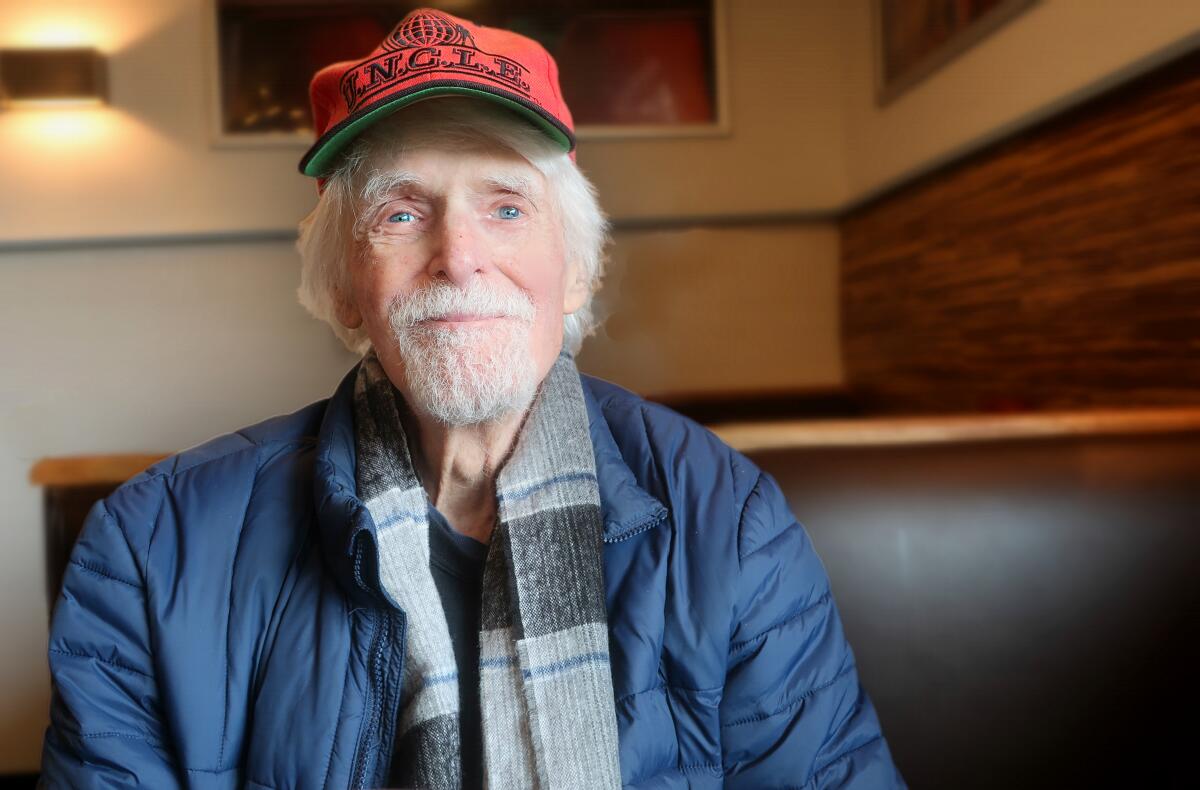Gary Kent, stuntman who inspired Tarantino’s ‘Once Upon a Time ... in Hollywood,’ dies at 89

Gary Kent, a celebrated B-list actor, director and stuntman, died Thursday at Onion Creek Nursing and Rehabilitation Center in Austin, Texas. He was 89.
Born June 7, 1933, in Walla Walla, Wash., Kent’s earliest films include 1959’s “Battle Flame.” He went on to act in several films the following decade — including the 1964 horror flick “The Thrill Killers,” the original “The Black Klansman” in 1966, and the 1968 biker film “The Savage Seven.”
In 1969, he was the stunt double for Bruce Dern in the psychedelic cult classic “Psych-Out,” which starred Jack Nicholson and Susan Strasberg. In preparation for the film, Kent went full method and dropped acid. He told the Austin American-Statesman in 2018 that the most dangerous stunt he’d ever performed was on that particular set and no, it wasn’t the drugs.
“I had to climb into this building and hang by my hands on the edge of this glass dome at this old art museum in L.A.,” he told the outlet. “I had to hang by my hands and swing onto this balcony and because of where the camera was, they couldn’t put any pads down. I barely made it.”
Other films for which he performed risky stunt work include “Hells Angels on Wheels,” “A Man Called Dagger,” “The Return of Count Yorga,” and most recently Don Coscarelli’s 2002 film “Bubba Ho-Tep.” He retired from performing stunts in 2003 after breaking his leg while shooting.
“My first stunt was going down the cellar stairs and I broke my arm,” Kent said in the 2018 documentary “Danger God,” which follows his nearly five-decade-long career.
“I went down the stairs on my tricycle, and the only one around was my sister Patty, and my mother said, ‘You were always that way, that started your stunt career.’”
Film reporters and critics from The Times discuss Quentin Tarantino’s highly personal historical epic “Once Upon a Time ... in Hollywood.”
Kent came by it honestly, from childhood through his teenage years. He knew that his moxie exceeded the norm.
“There was a bridge that went across Cedar River [in Washington] and there was a pipe railing on both sides that people could hold onto, and during the winter that would freeze over,” he recalled in the documentary.
“It became a big thing, summer or winter: Who had the guts to walk across the bridge on that pipe? Of course several people did it, but I did it when it was frozen over.”
Acting in a small theater in Corpus Christi, Texas, Kent fell in love with Joyce Peacock. Fresh out of the Naval Air Corps, Kent married her in the same town they met and together they raised three children, Greg, Colleen and Andy. When Kent knew he had to follow his dreams to Hollywood, he, Joyce and the kids packed up their life and moved west.
Eager to break into the film industry, Kent spent all day working in a production office and attended small drama groups at night, acting in plays until 1 a.m.
“You wouldn’t get paid a lot, but you’d always get paid, and it was wonderful just to get a job,” Kent recalled of his early days in show biz.
Although Kent’s ambition eventually led to the demise of his first marriage, he stayed in Los Angeles for 40 years, and married and ultimately separated from “The Thrill Killers” actress Rosemary Gallagly, who went by the stage name Laura Benedict.
Just like Cliff Booth, Brad Pitt’s character in “Once Upon a Time ... in Hollywood,” Kent had a run-in with Charles Manson and the “family” at Spahn Movie Ranch. A dune buggy that production was using as a camera car broke down on set, and Manson offered to repair it, but asked for a $70 advance. Kent paid up, but Manson reneged on his end of the deal until Kent threatened him.
“Charles got under the dune buggy and fixed it right away,” Kent said.
According to Joe O’Connell, the filmmaker behind “Danger God,” Quentin Tarantino interviewed Kent while working on the script for “Once Upon a Time ... in Hollywood.” Stuntman and director Hal Needham has also been noted as an inspiration for the character of Booth.
Sharon Tate’s life and death became an alluring portrait upon which to hang our what-ifs and darker fascinations.
Kent often portrayed thugs, rapists, outlaws and scoundrels in his films, but according to those who worked closely with him, his off-screen persona couldn’t be further from such “bad guy” roles. O’Connell became friends with the stuntman while filming his documentary, and they remained close for years. He told The Times, “Gary is the guy that guys wanted to hang out with. And women wanted to be near. Even as an old guy, he was just great. He just radiated a joy of life.”
In the 1970s, Kent traveled to Dallas to direct a film, but the funding fell through. He decided to stay anyway and went on to write and direct the dramatic 1976 film “The Pyramid,” which was recently included in the book “TCM Underground: 50 Must-See Films From the World of Classic Cult and Late-Night Cinema.”
He married the late dancer-turned-actress Tomi Barrett, who acted in “The Pyramid,” in 1977. She succumbed to lung cancer in 2005.
In 2009, Kent published a memoir, “Shadows & Light: Journeys With Outlaws in Revolutionary Hollywood,” detailing his colorful decades spent performing wild and high-risk stunts in cult classics and low-budget gems.
Toward the end of Kent’s life, O’Connell frequently visited him at his nursing home in Texas. And Sunday, Kent requested “puffy Cheetos and a Pepsi.” Ahead of the visit, O’Connell posted on Facebook asking fans and friends of Kent to leave messages in the comments.
“And so I sat on that Sunday and read all the nice things people were saying about him,” O’Connell said. “And I think he enjoyed it.”
At the end of “Danger God” Kent sat at a desk cluttered with papers and told the camera, “If you want to have a happy life, find something you love and do it until you die.”
More to Read
The biggest entertainment stories
Get our big stories about Hollywood, film, television, music, arts, culture and more right in your inbox as soon as they publish.
You may occasionally receive promotional content from the Los Angeles Times.











